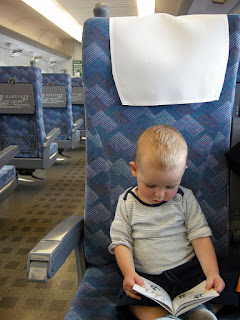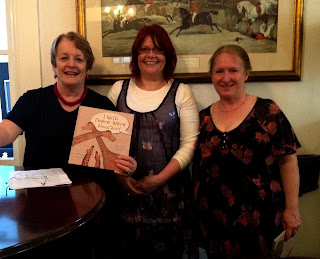“What
have you read lately?” My mind went blank and I felt silly and
ashamed. With wonderful publishers’ reps, a great request service
at the library and a huge pile of books by the bed, I always have
books to read. So here is the list of the books I have read (in
print and in audio formats) over the last month.
Charlie
Carter Omega Squad: Time
Thieves (Pan Macmillan)
The
first book in series following from the very successful Battle
Boy
series. A clever action-packed history lesson that will appeal to
children aged 6-10 years.
Cathryn
Constable Wolf Princess
(Chicken House) due in November 2012
Orphaned
Sophie Smith lives in a dreary boarding school in London, but dreams
of adventure, of forests and snow. She can barely believe her luck
when she and her friends land a place on the school trip to St.
Petersburg in Russia. But things don’t go quite to plan once they
arrive. A magical fairy tale
adventure for girls aged 9- 13.
Gary
Crew & Ross Watkins
The Boy Who Grew into a Tree (Penguin)
A fable
about nature and our relationship with it, and about the inevitable
cycle of life.
Stephen
Dando-Collins Caesar the War
Dog Random House
Caesar the
War Dog is based on the true story of Australian military dog Sarbi
and its experiences in Afghanistan, combined with the factual
experiences of Endal, the devoted British dog who cared for his
wheelchair-bound ex-serviceman master. For those who enjoyed Michael
Morpurgo’s Shadow.
James
Dashner Infinity Ring: A Mutiny
in Time (Scholastic)
When best
friends Dak Smyth and Sera Froste stumble upon the secret of
time travel — a hand-held device known as the Infinity Ring —
they’re swept up in a centuries-long secret war for the fate of
mankind. First of a seven book multi author series with a
multi-dimensional game at www.infinityring.com
Nick Earls
& Terry Whidborne Word
Hunters: The Curious Dictionary
(UQP)
When twins
Al and Lexi Hunter stumble on an old dictionary, they are catapulted
back through time and space, with only some mysterious pegs as clues.
They travel through time to discover the origin of particular words.
I enjoyed the concept and the
humour but some children may need encouragement at the beginning.
First in a series for children aged 9-13.
Elizabeth
Fensham Matty and Bill for
Keeps (UQP)
Matty and
Bill’s adventures continue – helping a visiting English boy
escape Isabelle Farquay-Jones, ensuring Bill’s dad Troy isn’t
caught up in illegal activities and learning secret cultural
practices. A warm story about friendship and growing up for younger
readers.
Anna
Fienberg & Stephen Michael King Figaro
and Rumba and the Crocodile Cafe
(Allen & Unwin)
A picture
book in six chapters. The irrepressible Figaro, a dog, and his
cat-friend Rumba get caught up in cat-napping adventure when they
ride the Very Fast Train.
Anna
Fienberg Louis Beside Himself
(Allen & Unwin)
Louis loves
words! His father would prefer Louis to learn wrestling techniques.
When a burglar breaks into the house, Louis fails to protect himself
and ends up providing a refuge for the intruder instead. A humorous
and entertaining read for middle school readers.
Mem Fox and
Judy Horacek Good Night, Sleep
Tight (Scholastic)
The story
of Bonnie, Ben and their babysitter and the traditional nursery
rhymes he tells them at bedtime.
Kelly
Gardiner Act of Faith
(HarperCollins)
Set in
Cromwellian London and Europe during the Spanish Inquisition – the
story of Isabella Hawkins caught up in the writing, printing and
disseminating of contentious books. Thanks to Jenni Connor for
recommending this CBCA 2012 Notable title.
Morris
Gleitzman After
(Penguin)
Continues
Felix's adventures in World War Two, where he faces perhaps his
greatest challenge - to reconcile hatred and healing and to find hope
when he's lost almost everything. If you loved Once
and Then,
buy this.
Jane Godwin
& Anna Walker Today We Have
No Plans (Puffin)
Weeks
are frantic- swimming lessons, orchestra, library, netball and
soccer, school lunches to prepare, notes to sign ... and then Sunday
comes. By the creators of All
Through the Year – on
my Christmas wish list
Oliver
Jeffers This Moose Belongs to
Me (HarperCollins)
I’m not a
fan but this is wonderful. As with his other books the moral seems to
be presented for the reader while the main character doesn't really
change his ways.
Catherine
Jinks The Reformed Vampire
Support Group (Allen &
Unwin)
Not the
usual sexy powerful vampires but a fun satire and a new look at the
lives of vampires.
Diana Wynne
Jones The Ogre downstairs
(Pan Macmillan)
Two
families were merged after remarriage. The ogre (the step-father)
brought each pair of children a magical chemistry set. A spot-on
portrayal of how children interact with adults, with hilarious and
memorable mixups.
Julia
Lawrinson Losing it (Penguin)
Four girls
in Year 12 make a bet: to lose it
before schoolies week – and preferably in a romantic, sober way
that they won't regret. Graphic,
embarrassing and hilarious; a serious story about choices and
relationships. Highly recommended. 14+
Candice
Scott Lemon Hubert
and the Magic Glasses New
Frontier Publishing (Little Rockets series)
Hubert has
poor soccer skills until he gets glasses. Fast paced stories for
children aged 7+
Steven
Lochran Goldrush Vanguard Prime
(Penguin)
It starts
slowly, has too many Americaniams, and a reluctant superhero who is
just a loser. Keep reading for strongly drawn characters - the
terrific superheroes: Agent Alpha, Gaia, Knight of Wands and Machina;
larger than life villains: Metatron, Overman and Major Arcana,
explosive action and flashes of humour. This promises to be a popular
series for middle school children and reluctant readers.
Marianne
Musgrove The Beginner’s Guide
to Revenge (Woolshed Press)
A soldier’s
daughter, 13 year old Romola has often moved, so making friends is
difficult. Sebastian is trying to find his father and stop his mum
from remarrying. Romola is “corrupted” by Sebastian’s payback
mentality learned from his reading about the extreme behaviour of
ancient gods. Both find that revenge has unpleasant consequences.
Story of family life with links to Legacy. Engaging read.
Lorin
Nicholson The Amazing Bike Ride
(Wombat Books)
This is a
true story about a boy who decides to ride over the mountains despite
his lack of vision. Aimed at children, this is an awesome story that
will encourage every reader, young and old.
Sally
Odgers & Lisa Stewart Bushland
Lullaby (Scholastic)
A
beautifully illustrated book of Australian animals with a gentle
rhyme which will appeal to children and adults alike. (Tasmanian
author)
Annabel
Pitcher Ketchup Clouds
(Orion) due November
Very
different to the award winning My
Sister Lives on the Mantelpiece.
Zoe writes to a man on Death Row; her letters are a confession for a
crime she committed, and to all intents and purposes, got away with.
A story of teenage relationships intermingled with family problems;
at times brutally revealing, an emotional read.
Tohby
Riddle Unforgotten
(Allen & Unwin)
The text is
a simple poem. The pictures are thought-provoking.
A book to be read and reread.
Emily Rodda
The Silver Door
(Scholastic)
Further
adventures of Rye and Sonia in the world beyond the Wall of Weld.
Highly recommended.
Veronica
Roth Insurgent
(HarperCollins)
An
addictive sequel to Divergent,
a bleak dystopian Chicago
ruled by "factions" exemplifying different personality
traits collapses into all-out civil war. The violence is graphic,
grisly and shockingly indiscriminate.
Marcus
Sedgwick
Fright Forest Elf Girl and Raven Boy (Orion)
Elf
Girl and Raven Boy are very different from each other, but they join
forces to find out who is destroying their home. Perfect for
8-12 year olds who love adventure, a touch of magic, or just a really
funny story.
Rebecca
Stead Liar & Spy
(Text)
A
seventh-grade boy who is coping with social and economic issues moves
into a new apartment building, where he makes friends with an
over-imaginative home-schooled boy and his eccentric family. A
delightfully quirky tale by a Newbery Award winner.
Laini
Taylor Daughter of Smoke and
Bone (Hodder)
A story of
star-crossed lovers – in this case an angel and a demon. Powerful,
emotive and brilliant writing. Looking forward to the sequel in
November.
Vikki
Wakefield All I ever wanted
(Text)
A brutally
honest slice of life on the other side of the tracks. A CBCA 2012
Notable. Looking forward to reading her next book Friday
Brown.
The adult
reads:
David
Baldacci Divine Justice
(Macmillan)
 The usual
action packed good guy versus corrupt government officials.
The usual
action packed good guy versus corrupt government officials.
Anne
Bartlett Knitting (Penguin)
A chance
meeting sparks a friendship between two very different women –
recently widowed Sandra, a rigid academic, and Martha, a knitter with
her own secret store of grief. Anne Bartlett is currently an author
in residence in southern Tasmania.
Chris
Cleave Gold
(Sceptre)
The story
of two cyclists, who are competitors for a spot in the Olympic Games
team and what drives them to succeed. Thankfully, not as horrifying
as The Other Hand.
Lene
Kaaberbol & Agnete Friis Boy
in the Suitcase (Soho Press)
Do you
remember her Tasmanian visit in 2006 with her excellent fantasy
series - Shamer’s Daughter? This is the first English translation
of a crime series starring Nina Borg, a Red Cross nurse, wife, and
mother of two, and a compulsive do-gooder. For fans of Wallander and
The Killing.
Lynne Truss
Talk to the Hand: The Utter
Bloody Rudeness of the World Today, or Six Good Reasons to Stay Home
and Bolt the Door (Fourth
Estate)
A rallying
cry for courtesy.
Currently
reading Lian Tanner’s Path of
Beasts (Allen & Unwin) and listening to Catherynne
M. Valente The
Girl Who Circumnavigated Fairyland in a Ship of Her Own Making
(Corsair). Wonderful
so far. Looks like I’ll be purchasing the sequel.
It's Monday! What are YOU reading?



















